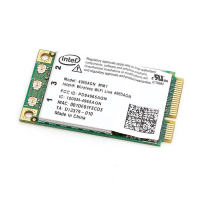● Radio Management
WEP Encryption
Use IEEE 802.11 Wired Equivalent Privacy (WEP) encryption to prevent
unauthorized reception of wireless data. WEP encryption provides two levels of
security that use a 64-bit key (sometimes referred to as 40-bit) or a 128-bit key
(also known as 104-bit). For stronger security, use a 128-bit key. If you use
encryption, all wireless devices on your wireless network must use the same
encryption keys.
Wired Equivalent Privacy (WEP) encryption and shared authentication provide
protection for your data on the network. WEP uses an encryption key to encrypt
data before transmitting it. Only computers that use the same encryption key can
access the network or decrypt the encrypted data transmitted by other computers.
Authentication provides an additional validation process from the adapter to the
access point.
The WEP encryption algorithm is vulnerable to passive and active network attacks.
TKIP and CKIP algorithms include enhancements to the WEP protocol that mitigate
existing network attacks and address its shortcomings.
Open and Shared Key Authentication
IEEE 802.11 supports two types of network authentication methods: Open System
and Shared Key.
● Open authentication: Any wireless station can request authentication. The
station that needs to authenticate with another wireless station sends an
authentication management request that contains the identity of the sending
station. The receiving station or access point grants any request for
authentication. Open authentication allows any device network access. If no
encryption is enabled on the network, any device that knows the Service Set
Identifier (SSID) of the access point can gain access to the network.
● Shared Key authentication: Each wireless station is assumed to have
received a secret shared key over a secure channel that is independent from
the 802.11 wireless network communications channel. Shared key
authentication requires that the client configure a static WEP key. The client
access is granted only if it passes a challenge-based authentication.

